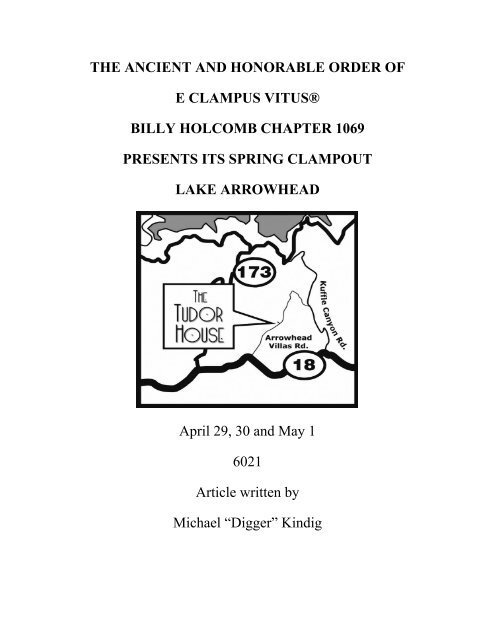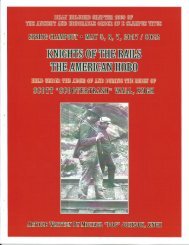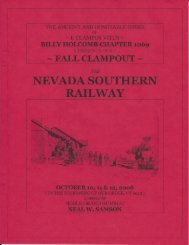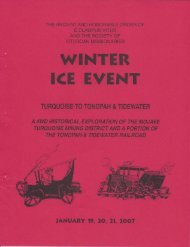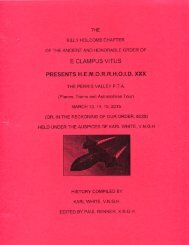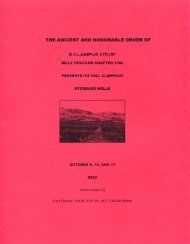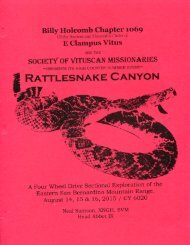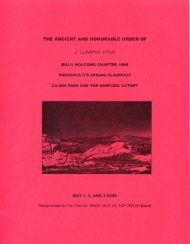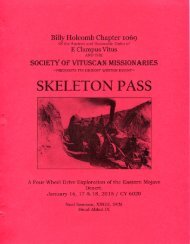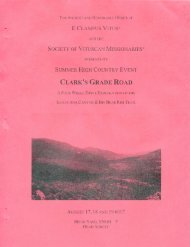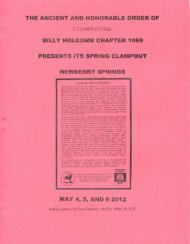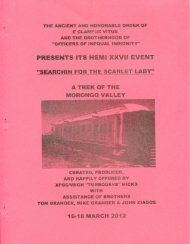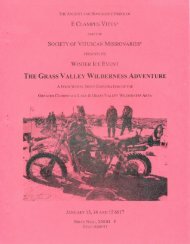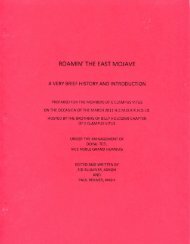6021/2016 Spring Clampout \"The Tudor House\"
Create successful ePaper yourself
Turn your PDF publications into a flip-book with our unique Google optimized e-Paper software.
THE ANCIENT AND HONORABLE ORDER OF<br />
E CLAMPUS VITUS®<br />
BILLY HOLCOMB CHAPTER 1069<br />
PRESENTS ITS SPRING CLAMPOUT<br />
LAKE ARROWHEAD<br />
April 29, 30 and May 1<br />
<strong>6021</strong><br />
Article written by<br />
Michael “Digger” Kindig
THE ANCIENT AND HONORABLE ORDER OF<br />
E CLAMPUS VITUS®<br />
BILLY HOLCOMB CHAPTER 1069<br />
PRESENTS ITS SPRING CLAMPOUT<br />
LAKE ARROWHEAD<br />
April 29, 30 and May 1 <strong>2016</strong><br />
Or, in the year of our order,<br />
<strong>The</strong> Six Thousand and Twenty-first<br />
Held under the aegis of<br />
Karl “Pretty Boy” White, Noble Grand Humbug<br />
Article written by<br />
Michael “Digger” Kindig
Table of Contents<br />
San Bernardino Mountains and Bear Valley ................................................................................................ 2<br />
Arrowhead Landmark and Arrowhead <strong>Spring</strong>s ............................................................................................ 2<br />
Logging and Sawmills ................................................................................................................................... 3<br />
Little Bear Valley and Lake Arrowhead ........................................................................................................ 4<br />
Hollywood and the Mob .............................................................................................................................. 5<br />
Rise of the Atkins Corporation ..................................................................................................................... 6<br />
Arrowhead Villas and Club Arrowhead in the Pines .................................................................................... 7<br />
<strong>Tudor</strong> House ................................................................................................................................................ 9<br />
Bracken Fern Manor .................................................................................................................................. 10<br />
Bath House ................................................................................................................................................ 11<br />
Folklore and Ghost Stories ......................................................................................................................... 11<br />
Fall of the Atkins Corporation .................................................................................................................... 13<br />
Snow Valley Mountain Resort ................................................................................................................... 14<br />
Santa’s Village ............................................................................................................................................ 14
San Bernardino Mountains and Bear Valley<br />
<strong>The</strong> San Bernardino Mountains are part of the Transverse Ranges of Southern California and<br />
were formed by tectonic forces along the San Andreas Fault about eleven million years ago. This<br />
tectonic activity created some of the most diverse environments in the state—including both hot<br />
and cold springs. <strong>The</strong> rich biodiversity resulting from this region was utilized for at least 10,000-<br />
20,000 years by indigenous peoples who traveled here to hunt and to escape the desert heat (San<br />
Bernardino Mountains, 2015).<br />
<strong>The</strong> Yuhaviatam (“people of the pines”) began frequenting this region about 2,500 years ago and<br />
named their favorite food gathering and hunting area Yuhaviat (“pine place”). <strong>The</strong>y did not,<br />
however, hunt the grizzly bear—neither was bear meat eaten nor was bear fur ever worn. <strong>The</strong>y<br />
thought of these huge animals as their ancestors and treated them with respect. Spanish<br />
missionaries in the late 1700s named these peoples Serrano (“mountaineer” or “highlander”)<br />
(“<strong>The</strong> history of Big Bear Valley,” n.d.).<br />
In 1810, Spanish priest Francisco Dumetz established a supply station at a location between<br />
Mission San Gabriel Arcángel and the Colorado Desert. On May 20th, a capilla (“chapel”) was<br />
completed at Gaucháma (“place of abundant food and water”) and Dumetz named the valley<br />
after Saint Bernardino of Siena who died on this day in 1444. Controversy exists regarding the<br />
evidence of an expedition conducted from Mission San Gabriel, the exact location where the<br />
capilla was established, and the date (Harley, 1988). What is not controversial is that the name<br />
San Bernardino was later applied to the mountain, the forest, the city and the county.<br />
In May of 1842, Paiute Chief Walkara and nearly one hundred of his followers—including four<br />
mountain men—conducted one of the largest livestock raids in California history. This group of<br />
horse thieves and cattle rustlers drove a herd that numbered in the thousands into the high desert.<br />
In 1845, Benjamin Davis Wilson (aka “Don Benito”) was asked to pursue this renegade group of<br />
marauders and assembled a posse of 44 men composed of Californios and New Mexicans. He<br />
sent 22 men through the Cajon Pass and led the remaining 22 men through the San Bernardino<br />
Mountains. <strong>The</strong> posse found neither the stolen herd nor Walkara. What Wilson did find was<br />
Yuhaviat—the ancient and mysterious forest swarming with grizzly bear. However, unlike the<br />
Yuhaviatam, Wilson and his men hunted the grizzly and skinned them for their fur. This event<br />
prompted Wilson to refer to the area as Bear Valley (Core, 2002).<br />
Arrowhead Landmark and Arrowhead <strong>Spring</strong>s<br />
On the southern face of the San Bernardino Mountains, clearly visible from the San Bernardino<br />
Valley, is a landmark in the shape of an arrowhead. <strong>The</strong> landmark is 1,375 feet long, 449 feet<br />
wide, covers 7.4 acres, and is at an elevation of 2,800 feet. It is unknown how and when this<br />
peculiar landmark was formed. Indigenous peoples of various tribes in the area recount their<br />
respective creation stories that include an “arrow of light” that descended from the heavens.<br />
<strong>The</strong>re is no mention of the landmark found within the journals of Spanish expeditions in the<br />
Page 2
1770s, the Dumetz expedition in 1810, Mormon settlers in the 1850s, or the transcontinental<br />
railroad survey compiled by Robert Stockton Williamson in 1853. <strong>The</strong> first evidence of the<br />
landmark is a photograph taken in 1864, which shows the original buildings of Arrowhead<br />
<strong>Spring</strong>s Hotel (Meek, 2007).<br />
In 1857, a young immigrant from Ohio named David Noble Smith proposed to establish a<br />
hygienic infirmary at a location referred to by Spanish missionaries as “Agua Caliente”. In 1863,<br />
he opened a road to the hot springs and constructed the original infirmary building and<br />
bathhouses. In 1864, he opened the hot springs as a resort—Arrowhead <strong>Spring</strong>s Hygienic<br />
Infirmary or Arrowhead <strong>Spring</strong>s Hotel—and managed it until his death in 1885. Controversy<br />
exists regarding the origin of the landmark (Meek, 2007). What is not controversial is that Smith<br />
was the first to bestow the name of “Arrowhead” to the hot springs and the “Arrowhead” name<br />
was later applied to companies, the lake, and the city. On March 20, 1885—three days after<br />
Smith’s death—the first Arrowhead <strong>Spring</strong>s Hotel was destroyed by fire. A second hotel was<br />
built, but on July 4, 1895, it was destroyed by fire. A third hotel was built, but on November 23,<br />
1938, it was destroyed by fire. A fourth hotel was built and operated until 1962.<br />
L. Burr Belden suggested that Arrowhead <strong>Spring</strong>s “probably has the distinction of having more<br />
untruths written about it and recorded as fact than any other place with the possible exception of<br />
Death Valley” (Belden, 1952).<br />
Logging and Sawmills<br />
In 1857, many logging operations changed ownership when Brigham Young recalled the<br />
Mormons to Utah. Sawmill owners quickly sold their sawmill businesses or equipment to willing<br />
buyers. In 1860, William Stewart La Praix purchased equipment and opened the Excelsior<br />
Sawmill in Little Bear Valley. In 1885, he moved his mill to a different location in Little Bear<br />
Valley to shorten the distance from the mill to the trees he was cutting. His mill was producing<br />
between six hundred thousand and one million board feet of lumber per year. In 1887, La Praix<br />
was accidently killed when he fell into his machinery. His nephew, James Fleming, inherited his<br />
estate that not only included the mill, but 1,700 acres of virgin timber. In 1891, Fleming sold his<br />
operations, which he had renamed Fleming Creek Sawmill, to the Arrowhead Reservoir<br />
Company (Tetley, 2014).<br />
In the 1880s, most sawmills were producing about six million board feet of lumber per year. By<br />
the 1890s most of the large sawmills closed down in Little Bear Valley, but opened up in<br />
Running <strong>Spring</strong>s. In 1899, the Brookings Lumber Company—the largest logging and lumbering<br />
operation ever in the San Bernardino Mountains—operated on 8,000 acres and produced<br />
between ten and twelve million board feet of lumber per year. In 1905, logging in the San<br />
Bernardino Mountains peaked and by 1911 most of the virgin timber in the area was gone. In<br />
1912, the Brookings Lumber Company ceased production and moved to Oregon.<br />
Page 3
Little Bear Valley and Lake Arrowhead<br />
In April 1859, gold was discovered in Bear Valley and miners began working claims all over the<br />
San Bernardino Mountains. During this time, another valley was discovered to the west of Bear<br />
Valley near what is now referred to as Lake Arrowhead. <strong>The</strong> new valley was called Little Bear<br />
Valley to distinguish it from neighboring Bear Valley. <strong>The</strong> prefix of "Little" referred not to the<br />
size of bear, but to the size of the valley.<br />
Figure 1 - San Bernardino Mountains (1884)<br />
In 1890, San Bernardino City Engineer Adolph Heliodor Koebig had a plan to capture the vast<br />
watershed within the San Bernardino Mountains and supply it to the San Bernardino Valley. <strong>The</strong><br />
plan was to collect the tributaries from the headwaters of the Mojave River above 4,800 feet in<br />
elevation, to store this watershed in one or more reservoirs, and to deliver it for irrigation<br />
purposes to the valley below. He selected Little Bear Valley as the location for a large reservoir<br />
and dam and traveled to Cincinnati, Ohio to seek funding for the project. In December of 1890,<br />
the Arrowhead Reservoir Company filed articles of incorporation in Kentucky. Principle<br />
shareholders included James Norris Gamble, the son of Proctor & Gamble Company co-founder<br />
James Morris Gamble, and James Edmund Mooney (“<strong>The</strong> history of Lake Arrowhead,” n.d.).<br />
In 1892, construction on the dam began in Little Bear Gorge, land was purchased around the<br />
proposed reservoir, and water rights were obtained. In 1905, the Arrowhead Reservoir Company<br />
Page 4
e-incorporated as the Arrowhead Reservoir and Power Company. In 1918, the reservoir was<br />
filled for the first time. <strong>The</strong> resulting lake covered 782 acres, was 185 feet deep, and was called<br />
Little Bear Lake (Creason, 2015). On December 22, 1919, Mooney died. In 1921, the lake and<br />
over 5,000 acres of land around the lake were purchased by the Arrowhead Lake Company—a<br />
group of Los Angeles millionaires—for the sum of $625,000 with plans to develop a private<br />
resort for the elite. This group of millionaires included James Benton Van Nuys, the son of San<br />
Fernando farmer and rancher Isaac Newton Van Nuys, and Los Angeles attorney John<br />
O’Melveny. In 1922, the dam was completed, Lake Arrowhead Village was established, and the<br />
reservoir was renamed from Little Bear Lake to Lake Arrowhead.<br />
Figure 2 – Lake Arrowhead, by R. Winters (1925)<br />
Hollywood and the Mob<br />
More than 150 movies have been filmed in the San Bernardino Mountains. Maxwell Henry<br />
Aronson—often referred to as the father of the movie cowboy—was one of the first persons to<br />
use the San Bernardino Mountains in film. On March 11, 1911 he released a silent short film<br />
entitled <strong>The</strong> Romance on the ‘Bar O’, which he not only directed, but wrote, produced and<br />
starred under the name Gilbert M. “Broncho Bill” Anderson. Cecil Blount DeMille—<br />
Page 5
acknowledged as a founding father of the Hollywood film industry—was another person to use<br />
the San Bernardino Mountains in film. On February 15, 1915 he released a silent film entitled<br />
<strong>The</strong> Squaw Man starring William Faversham. Filming peaked between 1940 and 1970, but<br />
several movies continue to be filmed here each year.<br />
On January 16, 1920, when Congress ratified the Eighteenth Amendment, a nationwide<br />
prohibition period began that would last for nearly thirteen years. As a result, those who found<br />
pleasure in drinking—or the potential profits therein—found entrepreneurial ways around the<br />
law. Between 1930 and 1940, moonshine was illegally produced throughout the San Bernardino<br />
Mountains and bootlegging, as well as gambling and prostitution, operated quite effectively in<br />
these remote places.<br />
In December of 1938, the Arrowhead <strong>Spring</strong>s Hotel was purchased by the Arrowhead <strong>Spring</strong>s<br />
Corporation—a Hollywood consortium—for the sum of $800,000 with plans to develop a highend<br />
health spa for the elite. This consortium included 20th Century Fox founders Joseph M.<br />
Schenck, Darryl F. Zanuck, and William B. “Bill” Goetz, Jacob “Jay” Paley, the uncle of<br />
Columbia Broadcasting System (CBS) founder William S. Paley, leading actresses Constance<br />
Bennett and Claudette Colbert, and singer/comedian Al Jolson. <strong>The</strong> Arrowhead <strong>Spring</strong>s<br />
Corporation also purchased “Fish Camp” ski resort. Unfortunately, the hotel fell into financial<br />
trouble within a year, was briefly leased to Hollywood Reporter founder William Richard “Billy”<br />
Wilkerson, and closed in 1941 (San Buenaventura Research Associates, 2005).<br />
Wilkerson used his experience from the Arrowhead <strong>Spring</strong>s Hotel toward a new project in<br />
Nevada. Financial investments and construction guidance soon came from Benjamin Hymen<br />
“Bugsy” Siegelbaum, a mobster who moved from New York to Los Angeles in 1936 (Bugsy<br />
Siegel, <strong>2016</strong>). Siegel developed a friendship with Wilkerson when he began visiting his<br />
nightclubs, but eventually edged Wilkerson out and took over the project that he would later<br />
become famous for. On December 26, 1946 the Flamingo hotel and casino opened on the Las<br />
Vegas Strip (Fischer, 2005). Less than a year later, on the night of June 20, 1947, Siegel was shot<br />
dead in his girlfriend’s Beverly Hills home.<br />
Rise of the Atkins Corporation<br />
In 1918, two sets of brothers began conducting business together: Samuel and William<br />
Markowitz from Missouri and Joshua F. and Milton F. Simons from Wisconsin. <strong>The</strong> Markowitz<br />
brothers operated clothing and dry goods businesses in Venice as early as 1923 (Stanton, 2003).<br />
Having developed mutual ideals and sharing a desire to build a noteworthy business together,<br />
William Markowitz and Joshua Simons organized three corporations in Los Angeles, California:<br />
Atkins Realty Company (for the purpose of public sales); Atkins Corporation (for the purpose of<br />
holding the leases); and Atkins Development (for the purpose of construction). <strong>The</strong> principle<br />
headquarters were located at the Pacific National Bank Building in Los Angeles.<br />
Page 6
In December of 1925, the Atkins Realty Co., Inc. purchased 160 acres of land in the amount of<br />
$100,000 from Elida Wagner Fleming, the widow of James Fleming (Fleming Woods, 1925).<br />
<strong>The</strong> property, known as Fleming Woods, was the largest piece of privately owned land around<br />
Lake Arrowhead. <strong>The</strong>ir original vision was to subdivide the land into lots, to erect summer<br />
homes on those lots, and to create a unique recreational center that would both adhere to the high<br />
standards of the Lake Arrowhead community and stand above other mountain properties being<br />
offered to the public. This vision culminated into Arrowhead Villas and Club Arrowhead in the<br />
Pines—one of the first mountain recreation resorts ever planned.<br />
Arrowhead Villas and Club Arrowhead in the Pines<br />
In 1926, construction began on the complex of buildings that would transform the old Fleming<br />
Woods estate into the new Arrowhead Villas and Club Arrowhead in the Pines. <strong>The</strong> buildings<br />
included private homes comprising the Arrowhead Villas and the clubhouse, bathhouse,<br />
administration building, and stores comprising Club Arrowhead in the Pines. On February 27,<br />
1926, the Atkins Realty Co., Inc. ran a special 15-day pre-opening offer in the newspapers<br />
(“Atkins Realty Co. presents Arrowhead Villas,” 1926). <strong>The</strong>y marketed Arrowhead Villas as<br />
income property, whereby they would sell their client a lot and upon payment in full for the lot,<br />
they would finance, build, and furnish a home that could be used by the client or rented to the<br />
public. <strong>The</strong> offer made claims that all improvements would be put in absolutely free of cost to<br />
the buyer.<br />
On July 4, 1928, Club Arrowhead in the Pines officially opened. To coincide with this milestone,<br />
Markowitz and Simons published their first newsletter called Atkins Activities (Hochbaum,<br />
1928) along with an illustrated brochure with more details about the commercial mountain resort<br />
they were building. With respect to Arrowhead Villas, the newsletter and brochure teased<br />
potential buyers with options of one-room cottages, double cabins, or spacious lodges. Each<br />
mountain home was replete with electric lights and running water, private bath and showers,<br />
fireplaces or wood stoves, and kitchens or kitchenettes. Pure mountain spring water was piped to<br />
every site and telephone service would be available soon. Furnishings were provided by pioneer<br />
furniture company Barker Bros. Of the 1,500 available lots, 80 of those had mountain homes<br />
built on them.<br />
In Arrowhead Villas, with which most of you are familiar, we are building a recreational<br />
center which is yours to have and enjoy, and we trust that with Arrowhead Villas<br />
completed it will bring you many years of untold pleasures.<br />
Page 7
Figure 3 – Club Arrowhead in the Pines (1920s)<br />
With respect to Club Arrowhead in the Pines, the newsletter and brochure enticed potential<br />
buyers with descriptions of myriad recreational opportunities such as swimming, golf, tennis,<br />
horseback riding, boating, fishing, and hunting—all for a $250 Associate Life Membership. <strong>The</strong><br />
newsletter and brochure also flaunted winter recreational opportunities such as ice skating,<br />
snowshoeing, tobogganing, and skiing—featuring the first downhill ski run with a single towline<br />
in the San Bernardino Mountains. Over $1,500,000 was invested to make Club Arrowhead in the<br />
Pines an exceptional recreation center.<br />
<strong>The</strong> main clubhouse was generously proportioned and contained a spacious lounge forty feet<br />
wide by ninety feet long with lofted ceiling. <strong>The</strong> lounge included a radio, grand piano, and a<br />
polished maple floor for dancing. On special events, an orchestra would play there. <strong>The</strong><br />
clubhouse also contained a dining room, library, fireplace, and game rooms. Adjacent to the<br />
main clubhouse was an Olympic size swimming pool filled with pure mountain spring water.<br />
<strong>The</strong> nearby bathhouse contained lockers and showers. Lifeguards were on duty and swimming<br />
instructors could be requested.<br />
<strong>The</strong> club property included a concrete tennis courts and tennis lessons could be requested. It<br />
maintained a stable of horses for horseback riding and trainers could be requested. <strong>The</strong>re was<br />
also a children’s playground, which included a wading pool, sand court, swing and teeter-totter,<br />
and marble shoot.<br />
Page 8
Less than a mile from the club property was lovely Lake Arrowhead, which provided members<br />
with boating, fishing and hunting opportunities. Trout, perch, and catfish were re-stocked<br />
annually for interested anglers and ducks were abundant for waterfowl hunters. <strong>The</strong> club also<br />
had access to a nine-hole, championship golf course and practice putting green.<br />
On September 13, 1928, Markowitz and Simons filed articles of incorporation for the Arrowhead<br />
Villas Club at the San Bernardino County Clerk’s Office. <strong>The</strong> new company will be<br />
headquartered in Los Angeles and has large holdings in the Lake Arrowhead district (“Resort<br />
corporation files its articles,” 1928). On August 29, 1929, Markowitz and Simons filed articles of<br />
incorporation for the Arrowhead Villas Mutual Service Co. at the San Bernardino County<br />
Clerk’s Office. <strong>The</strong> new company will principally supply electricity and water to the Arrowhead<br />
Villas, as well as maintain roads and playgrounds. <strong>The</strong> new company was capitalized for<br />
$170,000, divided into 1,700 shares at a value of $100 per share (“Utility corporation,” 1929).<br />
<strong>Tudor</strong> House<br />
<strong>The</strong> <strong>Tudor</strong> House (aka “the clubhouse”) was built over two years and was dedicated on July 4,<br />
1928. It was architecturally influenced by the <strong>Tudor</strong> Revival style—a nod from architect William<br />
Henry Kraemer (Tetley, 2008b) to Henry the Eighth and the <strong>Tudor</strong> Dynasty. <strong>The</strong> 13,000 sq. ft.,<br />
two-story, special purpose building—and 10,000 sq. ft. finished underground works complete<br />
with tunnels and various trap doors—sits on a 36,958 sq. ft. lot adjacent to the Bracken Fern<br />
Manor.<br />
<strong>The</strong> clubhouse, known to longtime locals as the “Great Old Building,” has served many<br />
intermittent purposes since the closure of Club Arrowhead in the Pines. Such purposes include<br />
an antique furniture store, an apartment rental, a church, a club, a private residence, a real estate<br />
office, and a restaurant (Tetley, 2008a). In 1951, Robert Lee and Martin Eger purchased the<br />
property and operated a popular dining and dance hall (Walton, 1951). In 1975, Richard G.<br />
Bernier operated Club Arrowhead Square Realty there (“Club Arrowhead Square Realty,” 1975).<br />
In 1986, John H. Traband purchased the property and operated a restaurant he named the <strong>Tudor</strong><br />
House. In 2013, local residents John Connor and Peggy Butler purchased the clubhouse and<br />
formed <strong>Tudor</strong> House Productions, LLC—a dinner theater staging live plays.<br />
<strong>The</strong> clubhouse includes a main hall, industrial kitchen, wine cellar, office, master and upstairs<br />
apartments. <strong>The</strong> main hall is thirty feet wide by seventy feet long with a lofted ceiling. This<br />
arched construction allows for both impressive lighting and remarkable acoustics. Equally<br />
notable is the 16-foot wide fireplace composed of 70 tons of native stone. <strong>The</strong> mantle reads: This<br />
Seventy Tons Of Rock Is Here - To Bring You Comfort Warmth and Cheer - Through Winter<br />
Nights And Frosty Days - Its Genial Warmth And Ruddy Blaze - Will Bring To You <strong>The</strong> Sunshine<br />
Still - That Gathers From the Native Hills. <strong>The</strong> industrial kitchen is fully equipped and can<br />
provide multiple courses for over 100 dinners in a single night. <strong>The</strong> wine cellar is located below<br />
Page 9
ground in one of the old tunnels and can accommodate over 100 cases of wine. <strong>The</strong> High Tea<br />
Room is accessed through a door made with antique stained glass imported from an 1830s<br />
English pub. <strong>The</strong>re are two upstairs apartments. <strong>The</strong> upstairs east apartment includes a bedroom,<br />
large parlor and grotto, office, and bathroom with Jacuzzi. <strong>The</strong> upstairs west apartment includes<br />
a kitchen, dining room, bedroom, dressing room, and bathroom.<br />
Figure 4 – Sketch by M. Mehan (2013)<br />
Bracken Fern Manor<br />
Bracken Fern Manor (aka “the cottage”) was dedicated on July 4, 1929. It was architecturally<br />
influenced by the Alpine style—a nod to the origins of skiing in the Swiss Alps. <strong>The</strong> 4,500 sq.<br />
ft., three-story, hotel/motel building sits on an 8,500 sq. ft. lot adjacent to the <strong>Tudor</strong> House.<br />
<strong>The</strong> cottage was originally built as a lodge and market to accommodate visitors or potential<br />
property investors. Over the years, it has also served many intermittent purposes since the<br />
closure of Club Arrowhead in the Pines. Such purposes include a cabinet shop, a general store, a<br />
grocery store, and a hotel. In 1989, the hotel was purchased and restored over the next few years.<br />
On May 20, 1993 the Bracken Fern Manor Bed and Breakfast opened for business. It was named<br />
after the world’s most common type of fern (Pteridium aquilinum), which grows abundantly in<br />
this area.<br />
Page 10
On September 9, 1986 the cottage was evaluated as a potential California Point of Historical<br />
Interest and the evaluation was published in 1989 (Hatheway, 1989). According to the Office of<br />
Historical Preservation, a property cannot be listed as a California Point of Historical Interest<br />
(CPHI) and a California Historical Landmark (CHL). On August 14, 1989 the application was<br />
submitted for CPHI approval and a resource number of 36-015500 was assigned to it. An inquiry<br />
was sent by the property owner in February 1993, which stopped the approval process but a<br />
hearing by the State Historical Resources Commission was never scheduled. It is quite likely that<br />
additional documentation was required and was never submitted. As a result, there is no CPHI<br />
file on record for the Bracken Fern Manor.<br />
In 2014, <strong>Tudor</strong> House Productions, LLC purchased the cottage and retained its operation as a<br />
bed and breakfast. <strong>The</strong> Bracken Fern manor contains ten rooms: Ivy on the first floor; Lilly,<br />
Camellia, Rose, Violet, Jasmine, Dahlia, Daisy, and Heather (the Honeymoon Suite) on the<br />
second floor; and Fern (the Bridal Suite) on the third floor.<br />
Bath House<br />
<strong>The</strong> 4,000 sq. ft., three-story “bath house” building sits on a 45,000 sq. ft. lot adjacent to the<br />
<strong>Tudor</strong> House and Bracken Fern Manor. Originally, this building provided club members with<br />
many outdoor activities, including the Olympic size swimming pool, tennis courts, and riding<br />
stables. In 2015, <strong>Tudor</strong> House Productions, LLC also purchased this building and brought all<br />
three of the original Atkins Corporation buildings back under joint use ownership. Today, the<br />
lower level contains a microbrewery, the main level contains a second theater stage, and the<br />
upper level contains a gathering hall.<br />
Folklore and Ghost Stories<br />
Local legend suggests that Benjamin “Bugsy” Siegel was involved in illicit activities at Club<br />
Arrowhead in the Pines. Stories about his bootlegging enterprise include reference to a 500-<br />
gallon still that produced high quality liquor, Hollywood celebrities transporting it within special<br />
fuel tanks welded onto the undercarriages of their cars, and a trapdoor used to dispose of liquor<br />
bottles during Prohibition. Stories about his gambling enterprise include card and dice tables,<br />
“cash payout” slot machines, sliding wall panels, and hidden walkways used to observe gaming<br />
practices. Stories about his prostitution enterprise include reference to a high-class brothel that<br />
employed beautiful young women who catered to guests through underground tunnels. Some<br />
stories about law enforcement raids describe advanced warning systems where a mirror was used<br />
to send a signal from the Sheriff’s office to a child lookout on the mountain, which would<br />
provide operators enough time to conceal any illegal activity. Other stories about law<br />
enforcement raids describe the confiscation of a single slot machine’s outer casing and the<br />
charade of destroying it in front of local media (“<strong>The</strong> illicit side of the <strong>Tudor</strong> House,” 2015).<br />
Page 11
It is unknown how and when this notable folklore originated. Gambling in the San Bernardino<br />
Mountains likely existed as early as 1860 in the town of Belleville, located in Holcomb Valley.<br />
However, local newspapers didn’t begin reporting on illegal gambling raids in San Bernardino<br />
until after Prohibition ended in 1933. In April 1937, San Bernardino County Sheriff deputies<br />
raided the Morongo Lodge. Four men were arrested and gambling equipment—including a<br />
roulette wheel, slot machines, card and dice tables, and a chuck-a-luck cage was confiscated<br />
(“Officers raid gambling hall,” 1937). In July 1937, San Bernardino County Sheriff deputies<br />
raided Club Arrowhead in the Pines. Five men were arrested and gambling equipment valued at<br />
several thousand dollars was seized. (“Mountain club gamblers fined,” 1937). <strong>The</strong>re is no<br />
mention of Siegel, but both reports refer to those clubs being operated by Los Angeles "big<br />
shots”.<br />
In March and April of 1949, the Los Angeles Daily news published a list of slot machine<br />
statistics it had obtained from federal IRS tax records (“Slot machines,” 1949). Those articles<br />
provided the following data:<br />
California<br />
California<br />
San Bernardino County<br />
Big Bear<br />
Crestline<br />
Lake Arrowhead<br />
– 11,000 “amusement” slot machines<br />
– 3,322 “cash payout” slot machines<br />
– 1,096 “cash payout” slot machines<br />
– 137 “cash payout” slot machines<br />
– 43 “cash payout” slot machines<br />
– 10 “cash payout” slot machines<br />
<strong>The</strong> first evidence of mob involvement in Lake Arrowhead is testimony given by Meyer Harris<br />
“Mickey” Cohen in his 1961 tax fraud trial (“Mickey Cohen,” 1961). Cohen admitted running<br />
several illegal gaming operations in Los Angeles, Orange and San Bernardino Counties. <strong>The</strong> big<br />
casinos—each bringing in between $15,000 and $20,000 per month—were in Burbank, Lake<br />
Arrowhead, and Watts. <strong>The</strong>re is no mention of Siegel, but it is acknowledged that Cohen worked<br />
under him from 1939 to 1947. <strong>The</strong> first mention of Siegel having any relationship with Club<br />
Arrowhead in the Pines appears in 1989 (Weeks, 1989).<br />
Bracken Fern Manor has often been cited as being haunted based on strange scents, sights or<br />
sounds. Some visitors have reported seeing the apparition of a young woman referred to as<br />
Violet or reported smelling the lingering scent of her delicate perfume (Logue, 2011). Local<br />
folklore suggests that she was a former prostitute who committed suicide after the Mob killed her<br />
lover. Other visitors have reported hearing the playful noises of a young boy referred to as<br />
Rodney or reported seeing his little footprints in the snow (Clydesdale, n.d.). Local folklore<br />
suggests that he was the child of another prostitute who was accidently trampled by a team of<br />
horses. <strong>The</strong>se stories were featured in the October 29, 2001 episode of Haunted Hotels:<br />
Page 12
Season 1 Episode 101: <strong>The</strong> Ghosts Are Waiting<br />
And gangsters in the 1930’s were the downfall of a beautiful young woman named Violet,<br />
whose ghost still pines for a lost love at Lake Arrowhead’s Bracken Fern Manor.<br />
Fall of the Atkins Corporation<br />
<strong>The</strong> Arrowhead Villas and Club Arrowhead in the Pines projects appeared to be commendable<br />
enterprises. Markowitz and Simons had certainly developed the Fleming property by taking raw<br />
mountain land and beautifying it by adding homes and recreation facilities. However, this was<br />
accomplished through fraudulent acts. Markowitz and Simons directed salesmen to coerce<br />
purchasers to sign membership application blanks for an ostensible fee of $10, which were in<br />
fact $100 promissory notes (Simons v. United States, 1941).<br />
On March 27, 1934 Markowitz and Simons organized three corporations in Olympia,<br />
Washington: Peoples Gas & Oil Company (for the purpose of public sales); Peoples Gas & Oil<br />
Corporation (for the purpose of holding the leases); and Peoples Gas & Oil Development (for the<br />
purpose of drilling wells). <strong>The</strong> principle headquarters were located at the Pacific National Bank<br />
Building in Los Angeles.<br />
On April 4, 1934, Markowitz and Simons filed articles of incorporation for each of the three<br />
companies at the Thurston County Clerk’s Office. Each of the three companies as originally<br />
organized had a capital stock of 640 shares of $1.00 par value—with the Atkins Corporation<br />
receiving 224 of those shares.<br />
In 1938 several Peoples Gas & Oil employees were indicted in ten counts for violation of the<br />
mail fraud statute, in two counts for violations of the Securities Act of 1933, and in one count for<br />
conspiracy to violate the mail fraud statute and the Securities Act.<br />
On February 14, 1939 the Peoples Gas & Oil fraud trial began with federal grand jury<br />
indictments against 11 men on 33 counts of mail fraud, violation of the national securities act<br />
and conspiracy. On August 22, 1939 Markowitz and Simons were convicted with defrauding<br />
30,000 investors throughout Washington of $1,980,000. <strong>The</strong>y appealed. On April 21, 1941 the<br />
appeals court affirmed the district court’s judgment (Simons v. United States, 1941).<br />
Markowitz and Simons each faced a $10,000 fine and eight years in a penitentiary, but were<br />
given an extension to clear up their affairs before beginning their respective penitentiary<br />
sentences. When the two failed to appear in Seattle and begin serving their respective terms, their<br />
$55,000 bonds were forfeited and the two were considered fugitives from justice.<br />
Page 13
William Markowitz and Joshua Simons—both aged 43 years—died on December 7, 1941 in<br />
Fresno. <strong>The</strong>ir bodies were found in a locked car, which was discovered by a farmer in his fig<br />
orchard. Investigators said that the windows of the car were sealed with newspapers and that a<br />
hose was attached between the exhaust pipe and front of the car (“Fugitives”, 1941).<br />
Snow Valley Mountain Resort<br />
In the 1920s, John Joseph Swetkovich, III and his brother George James Swetkovich developed<br />
and operated a roadside resort in the San Bernardino Mountains on the site of their father’s Six-<br />
Bits Lumber Mill. <strong>The</strong> resort—named after a nearby pond known to fisherman and hunters—was<br />
referred to as “Fish Camp”. In 1924, local skiers began laying out trails and world-renowned<br />
aviation designer John Knudsen “Jack” Northrop built the first “sling lift” to transport skiers up<br />
the hill. In 1937, Norwegian ski jumper Sverre Engen built a small lodge to accommodate the<br />
increasing number of skiers and promoted the site as a commercial ski resort. In 1938,<br />
Arrowhead <strong>Spring</strong>s Corporation acquired the resort so they could offer their guests skiing in the<br />
winter, as well as swimming and tennis in the summer. In 1941, former United States ski jump<br />
champion Johnny Elvrum acquired “Fish Camp” for $5,000 and officially renamed it “Snow<br />
Valley Ski Resort” (“About us”, n.d.).<br />
Santa’s Village<br />
On December 19, 1953, the Saturday Evening Post published an article about a New York<br />
businessman who opened a theme park called Santa’s Workshop (White, 1953). <strong>The</strong> article was<br />
called Christmas is <strong>The</strong>ir Business and was read by Crestline resident Harold Glenn Holland.<br />
Holland discussed the article with Richard James “Dick” and Maurice James “Mac” McDonald<br />
who suggested that he franchise a set of similar theme parks. In 1954, Holland hired general<br />
contractor Joseph Putnam “Putty” Henck to begin construction on the first of five franchised<br />
theme parks under the newly formed Santa’s Village Corporation. On May 28, 1955—six weeks<br />
prior to Disneyland—Santa’s Village in Lake Arrowhead was opened to the public. In 1957,<br />
Santa’s Village in Scotts Valley (Santa Cruz Co., CA) was opened and in 1959, Santa’s Village<br />
in East Dundee (Kane Co., IL) was opened. <strong>The</strong> two remaining theme parks—Richmond Co.,<br />
VA and Camden Co., NJ—were never built. On March 1, 1998, the theme park closed due to<br />
reduced attendance and revenue. In 2014, local real estate developer Bill Johnson purchased 154<br />
acres of land in the amount of $6,000,000 with an ambition to redesign and to reopen the park<br />
(History of here.” n.d.; Santa’s Village, 2015).<br />
Page 14
References<br />
About us. (n.d.). Retrieved from http://www.snow-valley.com/about_us.html<br />
Atkins Realty Co. Presents Arrowhead Villas. [Advertisement] (1926, February 27). Santa Ana<br />
Register, p. 3.<br />
Belden, L. B. (1952, October 5). History in the making: Arrowhead resort first developed as spa<br />
in 1863. San Bernardino Sun-Telegram, p. 20.<br />
Bugsy Siegel. (<strong>2016</strong>, February 22). In Wikipedia. Retrieved from<br />
https://en.wikipedia.org/wiki/Bugsy_Siegel<br />
Club Arrowhead Square Realty. (1975, April 16). San Bernardino County Sun, p. 40.<br />
Core T. (2002). Bear Valley discovered – 1854. Big Bear: <strong>The</strong> first 100 years. Big Bear City,<br />
CA: Core Trust, pp.192-197.<br />
Clydesdale, P. (n.d.). Lake Arrowhead – Bracken Fern Manor. Retrieved from<br />
http://www.whitetrashpeg.com/California.htm<br />
Creason, G. (2015, May 27). CityDig : Lake Arrowhead looks like paradise in this 1925 map for<br />
tourists. Los Angeles Magazine. Retrieved from:<br />
http://www.lamag.com/citythinkblog/citydig-lake-arrowhead-looks-like-paradise-in-this-<br />
1925-map-for-tourists/<br />
Fischer, S. (2005). <strong>The</strong> Flamingo: the first years. Casino Chip and Token News, pp. 46-52.<br />
Fleming Woods. (1925, December 25). <strong>The</strong> San Bernardino Sun, p. 9.<br />
Fugitives from $1,980,000 fraud case kill selves. (1941, December 13). <strong>The</strong> Fresno Bee <strong>The</strong><br />
Republican, p. 1.<br />
Harley, R. B. (1988). Rev. Juan Caballeria: Historian or storyteller? Rethinking the 1810 Dumetz<br />
expedition. San Bernardino County Museum Association Quarterly, 35(2).<br />
Hatheway, R. G. (1989). Historical research / evaluation for “Bracken Fern Manor”.<br />
Hochbaum, M. (1928, June). Atkins Activities, 1(1).
<strong>The</strong> history of Big Bear Valley. (n.d.). Retrieved from<br />
http://www.bigbearlake.net/about-big-bear/history/<br />
<strong>The</strong> history of Lake Arrowhead. (n.d.). Rim of the World Historical Society. Retrieved from<br />
http://www.rimoftheworldhistory.com/la.html<br />
History of here. (n.d.). Retrieved from http://www.skyparksantasvillage.com/#!about/cjg9<br />
Logue, J. R. (2011, December 6). A ghost story. Retrieved from<br />
http://jrlogue.blogspot.com/2011/12/ghost-story.html<br />
Meek, N. (2007). Origin of the Arrowhead landmark near San Bernardino, California. <strong>The</strong><br />
California Geographer, 47.<br />
Mickey Cohen explains past bigtime gambling. (1961, June 22). <strong>The</strong> Spokseman-Review, p. 34.<br />
Mountain club gamblers fined $700. (1937, July 16). <strong>The</strong> San Bernardino County Sun, p. 13.<br />
Officers raid gambling hall. (1937, April 20). <strong>The</strong> San Bernardino County Sun, p. 9.<br />
Resort corporation files its articles. (1928, September 14). <strong>The</strong> San Bernardino Daily Sun,<br />
p. 15.<br />
San Bernardino Mountains. (2015, December 23). In Wikipedia. Retrieved from<br />
https://en.wikipedia.org/wiki/San_Bernardino_Mountains<br />
San Buenaventura Research Associates. (2005, February 16). Historic resources report<br />
Arrowhead <strong>Spring</strong>s Hotel San Bernardino, CA. Retrieved from:<br />
http://www.historicresources.com/reps/arrowhead_springs.pdf<br />
Santa’s Village (Lake Arrowhead). (2015, August 2). In Wikipedia. Retrieved from<br />
https://en.wikipedia.org/wiki/Santa%27s_Village_(Lake_Arrowhead)<br />
Simons v. United States, 119 F.2d 539, 550 (9th Cir., 1941) Retrieved from<br />
https://law.resource.org/pub/us/case/ca9/briefs/govuscourtsca9briefs2376/gov.uscourts.ca<br />
9.010325.b.02.pdf<br />
Slot machines flourish in San Bernardino County. (1949, March 30). Daily News, p. 1.
Tetley, R. (2008a). Club Arrowhead in the Pines (<strong>Tudor</strong> House) in Arrowhead Villas. <strong>The</strong><br />
Alpenhorn News.<br />
Tetley, R. (2008b). Club Arrowhead in the Pines aka <strong>Tudor</strong> House. <strong>The</strong> Alpenhorn News.<br />
Tetley, R. (2014). Lake Arrowhead chronicles. Charleston, SC: History Press.<br />
<strong>The</strong> illicit side of the <strong>Tudor</strong> House. (2015, November 9). Retrieved from<br />
http://www.tudorhouseentertainment.villas/#!blog/l5zxw<br />
Stanton, J. (2003, October 12). Venice & Ocean Park businesses 1907 – 1936. Retrieved from<br />
http://www.westland.net/venicehistory/articles/venicebusinesses.htm<br />
Utility corporation files articles in clerk’s office. (1929, August 30). San Bernardino Daily<br />
Sun, p. 11.<br />
Walton, R. (Ed.). (1951, June 3). Club Arrowhead has new owners. <strong>The</strong> San Bernardino County<br />
Sun, p. 2.<br />
Weeks, J. (1989, July 30). Lake Arrowhead caters to the rich and famous. <strong>The</strong> San Bernardino<br />
County Sun, p. 48.<br />
White, W. C. (1953, December 19). Christmas is their business. Saturday Evening Post, 226(25),<br />
p. 34.


